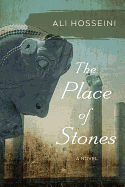
The Place of Stones by Ali Hosseini (The Lemon Grove) was originally published in Iran in 1997 and is Hosseini's second novel in English. The powerful Censorship Bureau of the Ministry of Culture and Islamic Guidance insisted on revisions that censored, among other elements, all literary references to female sexuality. This U.S. translation includes the deleted material. Hosseini also provides the censorship letter at the end of the book.
Haydar and Jamal, descended from farmers, struggle after a wealthy landowner forcibly takes their village's most fertile land. They are left with arid strips of land "that with each plowing produced more stones than anything worth harvesting." Jamal is in love with Haydar's beautiful sister and must find a way to earn a living if he is to marry her.
Hosseini shines his artistic magnifying glass on Haydar and Jamal's little village of Sangriz in Southern Iran at the cusp of the 1979 revolution. He gently unfolds the impact of the uprising and the inexorable forces of modernity on Sangriz and its neighboring city, where peace is shattered by civil unrest. Haydar and Jamal take markedly different paths: one rebels against the loss of his family's livelihood; the other succumbs to the inevitable onslaught of modernity by taking a job at the brick factory built on their ancestral lands. Hosseini's storytelling magically weaves together the lives of his characters pre- and post-revolution, leaving readers in no doubt that something is lost when the march toward modernization benefits a privileged few at the expense of the masses. --Shahina Piyarali, writer and reviewer.

